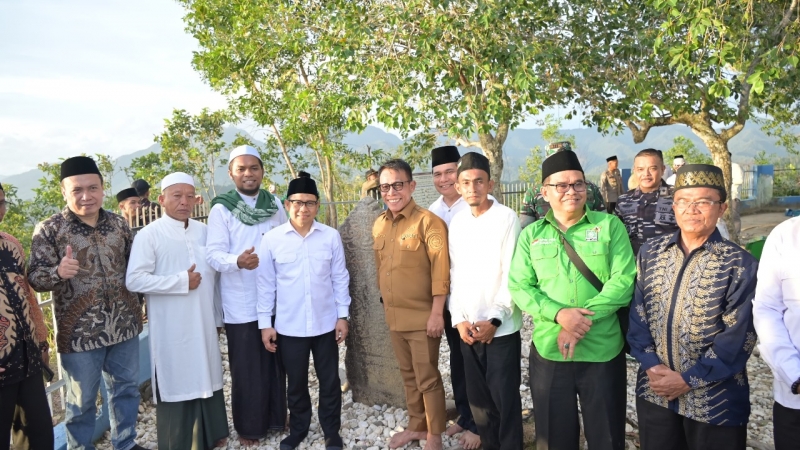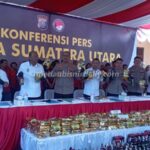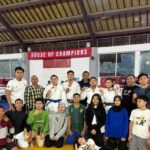During his visit to Tapteng, Coordinating Minister for Community Empowerment Muhaimin Iskandar (Cak Imin) took the time to visit the Papan Tinggi Tomb and the Mahligai Tomb in Barus, Central Tapanuli, North Sumatra.
Cak Imin, accompanied by his wife and a delegation of members of the House of Representatives, the Regent of Tapteng, and the Deputy Regent, was seen enthusiastically climbing the steps one by one.
“Alhamdulillah, I feel happy. The place is also nice,” said Cak Imin after the visit to the Papan Tinggi Tomb.
The two sites visited by Cak Imin are historical sites related to the spread of Islam in the archipelago. They also serve as evidence that Islam first entered from Barus.
The Papan Tinggi Tomb is the final resting place of Sheikh Mahmud. This location requires climbing nearly a thousand steps to reach.
The second site is the Mahligai Tomb, which contains around 215 graves of pious individuals. Reportedly, the oldest is the tomb of Sheikh Rukunuddin, who died in 672 AD.
Coordinating Minister Muhaimin Iskandar and his delegation performed joint prayers at both tomb locations and listened to explanations about the tombs and the inscriptions written on the tombstones of the saints.
When asked for his response regarding the construction of an escalator at the Papan Tinggi Tomb, Cak Imin expressed his agreement.
This would encourage pilgrims from other cities to come to Barus, thus boosting tourism in Tapteng globally.
“Yes, that’s good, so that tourism here becomes even busier,” Cak Imin added.
Papan Tinggi Tomb
The Papan Tinggi Tomb is a historic Islamic burial site located in Penang, Malaysia, believed to date back to the late 18th century. It is the final resting place of prominent early Muslim settlers and religious figures, including Syeikh Omar Basheer and members of the Sharifah family. The site is recognized for its historical significance in the region’s Islamic heritage and features traditional Malay grave markers.
Mahligai Tomb
The Mahligai Tomb is a historic mausoleum located in Banten, Indonesia, believed to date back to the 16th century during the Banten Sultanate. It is traditionally associated with the burial place of Maulana Yusuf, one of the sultans who played a key role in the spread of Islam in the region. The site reflects a blend of Islamic and local architectural influences, serving as an important cultural and religious landmark.
Barus
Barus is a historic coastal town on the western coast of Sumatra, Indonesia, renowned as a major global trading center for camphor and other forest products from at least the 6th to the 17th centuries. It was a crucial hub for traders from India, the Middle East, and China, and archaeological findings, including ancient Tamil inscriptions, confirm its importance in early transoceanic commerce. The town’s prominence declined with the rise of other port cities and European colonial powers in the region.
Central Tapanuli
Central Tapanuli is a regency located in North Sumatra, Indonesia, historically significant as the heartland of the Batak Angkola people. The region is known for its traditional adat (customary law), distinctive rumah adat (traditional houses), and rich cultural heritage. A key historical site is the ancient port of Barus on its western coast, which was a famed trading center for camphor and other spices as early as the first millennium CE.
North Sumatra
North Sumatra is a province on the Indonesian island of Sumatra, renowned for its stunning natural landscapes centered around Lake Toba, the largest volcanic lake in the world. The region is the homeland of the Batak people, whose distinct cultures and traditions, including unique traditional houses and music, have a long history in the area. Historically, it was also the seat of several significant kingdoms and later became a major center for trade and plantation agriculture under Dutch colonial rule.
Tapteng
I am unable to provide a summary for “Tapteng” as I cannot confidently identify it as a specific, well-known place or cultural site. The name could potentially refer to a location in Indonesia, but without more specific context, I cannot verify its history or significance.
Sheikh Mahmud
Sheikh Mahmud refers to Sheikh Mahmud Barzanji, a prominent Kurdish leader who led several uprisings against British rule in the early 20th century in the region that is now Iraqi Kurdistan. He famously declared a short-lived Kurdish kingdom in the city of Sulaymaniyah in 1922. He remains a significant and controversial figure, celebrated as a Kurdish nationalist hero but viewed by the British and Iraqi governments of the time as a rebellious leader.
Sheikh Rukunuddin
Sheikh Rukunuddin is a revered Sufi saint whose shrine is located in the city of Multan, Pakistan. The site is a significant spiritual and cultural center, attracting pilgrims for centuries due to its association with the saint’s legacy of Islamic mysticism. The shrine itself is an example of historic Islamic architecture, contributing to Multan’s identity as the “City of Saints.”






